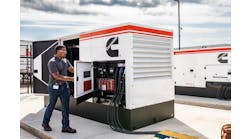Why the Engines Powering Your Generator Matter and the Benefits of Multiplying Them in a Single Microgrid
Darren Tasker, vice president of industrial sales at Volvo Penta of the Americas, explores why the engine powering your microgrid generator matters and how using multiple generators in a single microgrid application can actually be a source of cost savings.
Microgrids often operate in demanding environments or mission critical situations where downtime is just not an option. A key to ensuring continuity and uninterrupted operation of the microgrid is having a dependable power source behind it.
While some organizations may focus solely on the company supplying the generator, there is significant upside to carefully considering the engine that’s powering it. The outcome of such an analysis can mean improved operational efficiencies, enhanced reliability and an overall lower total cost of ownership.
So, what should companies look at when assessing the engine inside the generator? For starters, pay close attention to reliability. Whenever power is required, it’s essential that an engine operates efficiently. Look for a brand with a reputation for dependability and a product built to last. Perhaps as equally important is knowing that the engine will deliver the powerful performance you need. For this, examine the power density and load balance capabilities. Then there are factors such as fuel efficiency, ease of maintenance and a strong service network to support when needed. Each of these has the potential to contribute to a favorable total cost of ownership for the operators.
Another element that is emerging more commonly as a key point of consideration is emissions output. Organizations may opt to partner with a provider that can offer low emission levels to meet growing regulatory and societal demands for more environmentally friendly operations and a reduced carbon footprint.
Finally, there is the packaging and installation. Microgrid operators should look for optimal use of space and how well the engine is packaged. When it comes to this, some organizations may find it surprising to learn that using multiple generators in a single microgrid application can actually be a source of cost savings. The approach of paralleling and synchronizing generators has been proven in the industry by our partner and distributed energy innovation company, PowerSecure.
Using multiple generators in a single microgrid can actually save money. Photo courtesy of Volvo Penta.
One might naturally think that the cost of several generators would be significantly higher than the price of just one, but that is not always the case. A look at the overall total cost of ownership proves the value in this unique approach. The benefits extend far beyond the bottom line as well, touching on several of the factors we addressed earlier in this piece.
Paralleling and synchronizing generators produces reliable power with six key benefits:
- Joined generators: Joining generators is easy from an electrical perspective. When tied together, generators synchronize and load share.
- Redundancy: Using multiple generators builds redundancy. If one engine fails, the others keep working. When the operation requires a smaller power load, it’s unnecessary to engage every engine.
- Cost-effective operation: Sometimes microgrids must produce a smaller energy load than the total energy the system can produce. Joining multiple generators allows users to turn on one or two generators to produce needed energy and save money. Let’s say a system only needs 2 MW of power, but the microgrid uses a 3.5-megawatt generator. When the system turns on, the system wastes 1.5 MW of energy. Equipping the same microgrid with three smaller 1-MW generators allows users to turn on two and shut off the third. Plus, running engines with at least a 60% load is best from an emissions, efficiency and longevity perspective.
- Reduced maintenance: Some studies show using multiple, smaller generators in a microgrid lowers maintenance needs and costs. Smaller generators take less time and cost to support than a larger generator. One study compared the maintenance needs of one larger competitive generator against five smaller ones. The research found that the time to drain oil and the cost to change filters on the larger unit far exceeded routine maintenance for all five smaller units.
- Saves space: It’s possible to stack engines when space is at a premium. For example, generators can be installed in shipping containers that are designed to be stacked, therefore saving space.
- Emissions reduction: Multiple generators can meet high power requirements and adjust for lower demand. A microgrid designed to deliver 40 MW can run with five generators, two, or even one, depending on load. The solution is efficient, flexible and lowers emissions. When the microgrid uses Tier 4 Final engines, like those from Volvo Penta, the system operates efficiently and emits less CO, NoX and PM, reducing its carbon footprint.
Reducing emissions and boosting efficiency benefits operators through lower cost of ownership.
Darren Tasker is vice president of industrial sales at Volvo Penta of the Americas.







